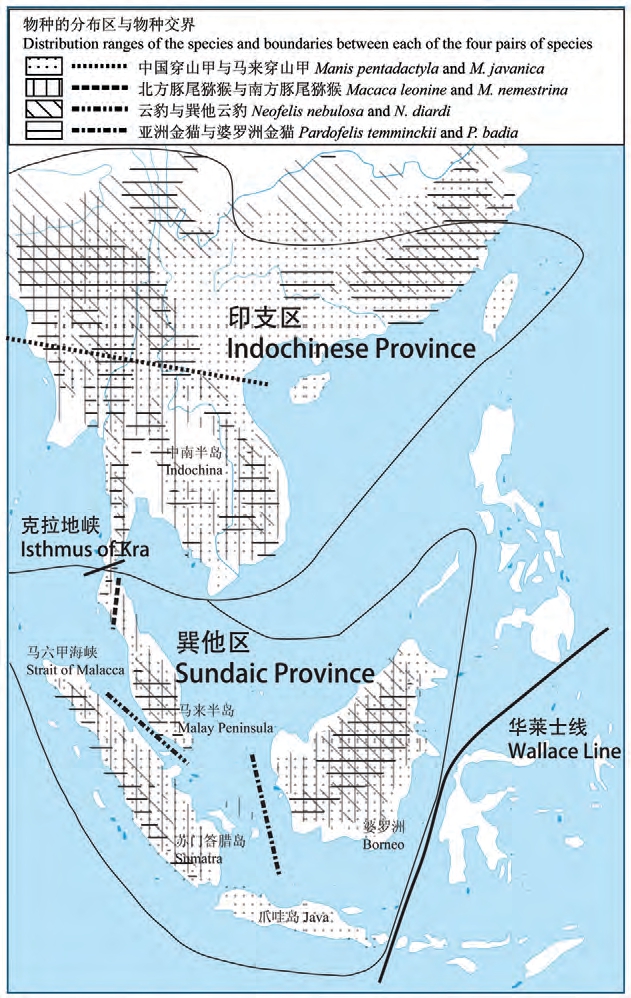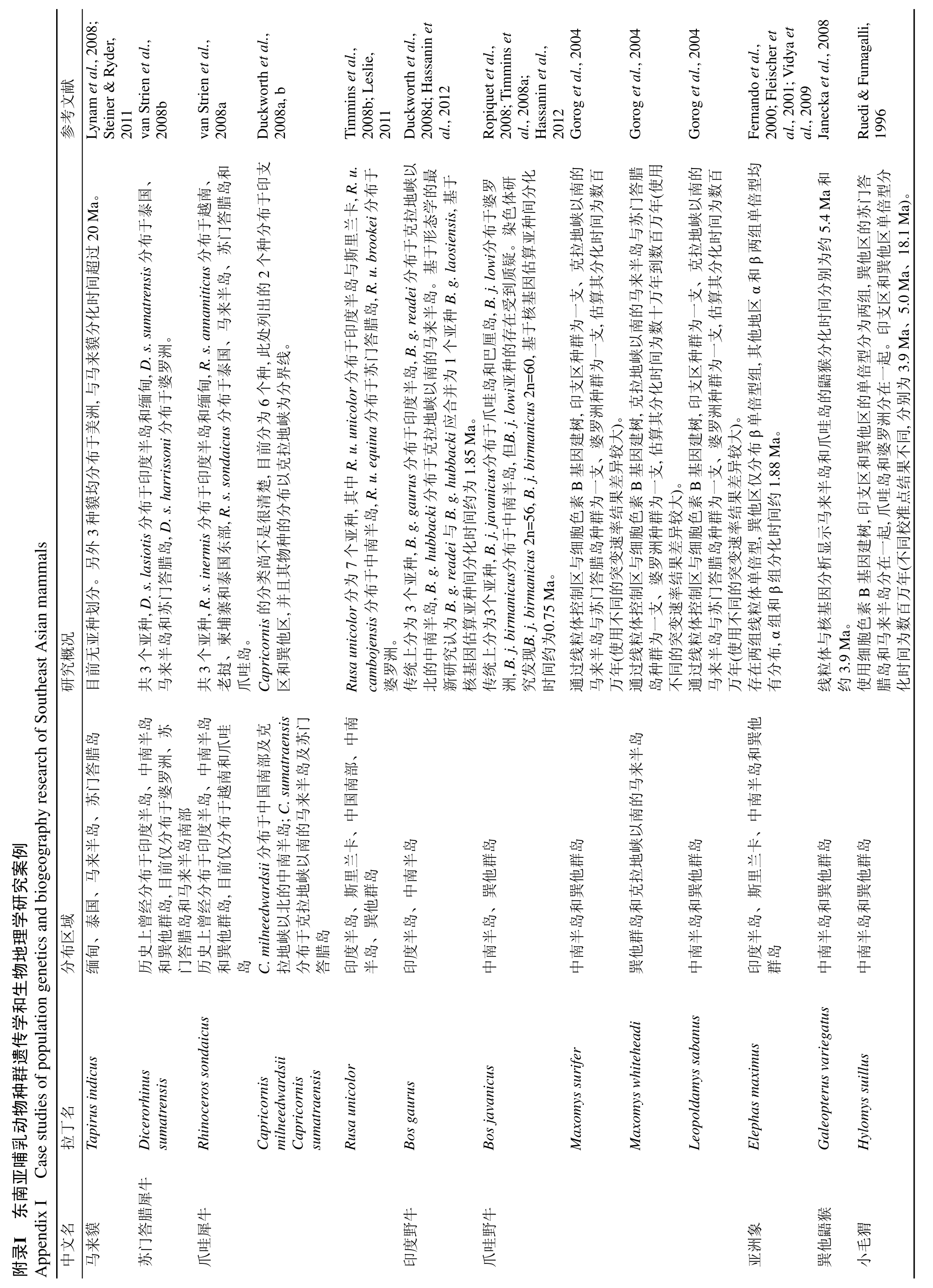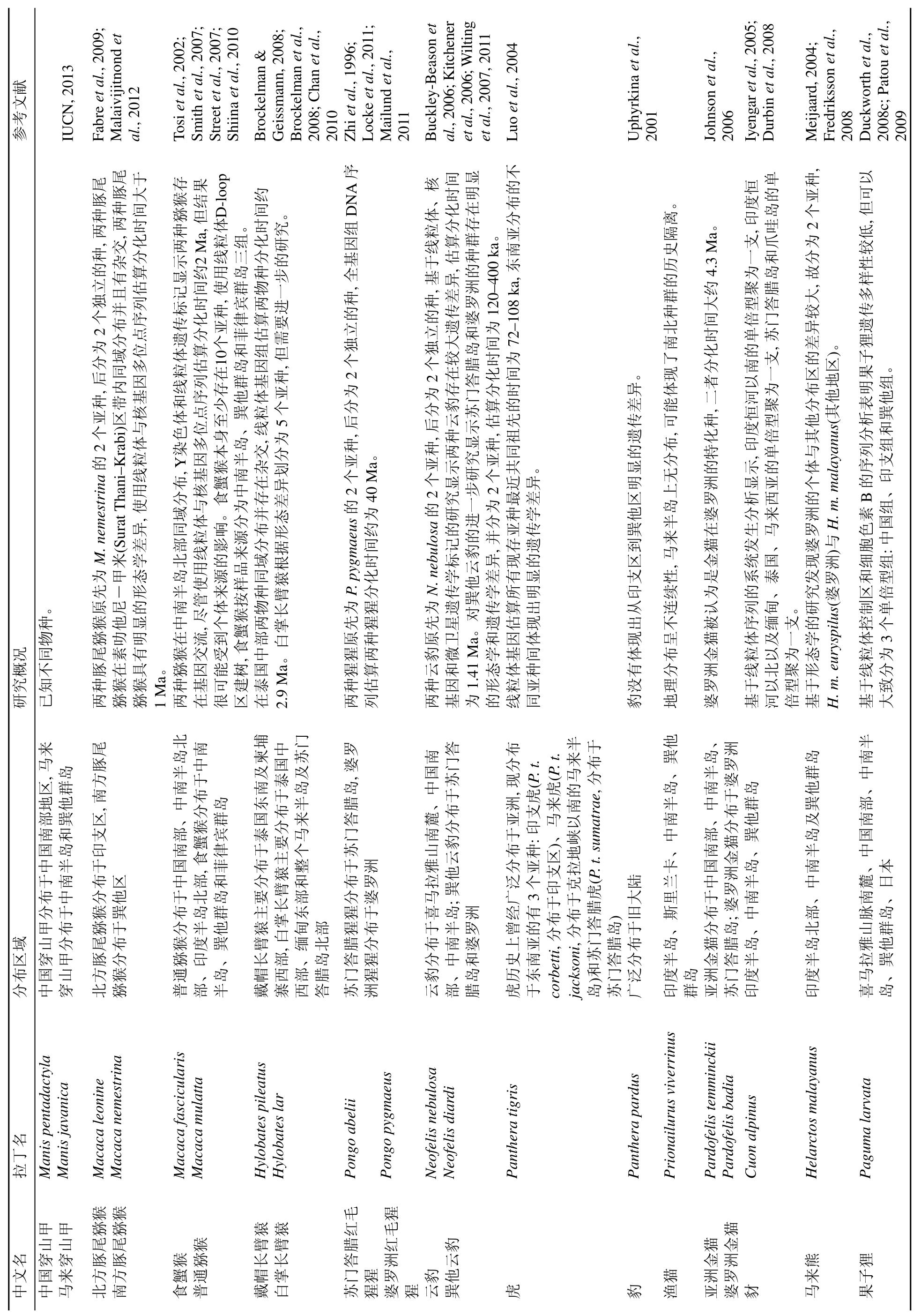基因组时代的新视野:东南亚哺乳动物类群在第四纪冰河时期多样性的起源与分化
【类型】期刊
【作者】苗林,罗述金(北京大学生命科学学院;北京大学-清华大学生命科学联合中心;北京大学–清华大学生命科学联合中心)
【作者单位】北京大学生命科学学院;北京大学-清华大学生命科学联合中心;北京大学–清华大学生命科学联合中心
【刊名】生物多样性
【关键词】 东南亚;生物地理学;哺乳动物;种群基因组学;第四纪
【资助项】国家自然科学基金面上项目(31271320)
【ISSN号】1005-0094
【页码】P40-54
【年份】2019
【期号】第1期
【期刊卷】1;|7;|8
【摘要】东南亚地区东起菲律宾群岛,西至印度次大陆,北及中国中部,南至巽他群岛,涵盖了世界上25个最重要的生物多样性热点地区之中的6个,具有极其重要的全球生物多样性保护的战略意义。该地区复杂的地质地貌和气候历史使其动植物的种类和数量都极为丰富。经典的生物地理分界线华莱士线和克拉地峡将该地区进一步划分出包括部分巽他群岛和马来半岛在内的南部巽他区和北部印度支那区两个生物多样性热点地区。主要基于形态学的生物地理学研究认为巽他区和印度支那区通过马来半岛陆地相连,并且第四纪大部分时间海平面下降形成大陆桥,直到一万年前该地区的众多岛屿仍与大陆连接,促进了哺乳动物的种群迁徙与基因交流,因此物种种群间的差别将很细微。然而近来分子遗传学研究表明,由于其他生态因素制约,哺乳动物的迁移能力可能比以往认为的低,大陆桥的存在并不一定导致迁徙的发生,许多种群的隔离早在200万年前便已形成,并且没有因为后来冰川期海平面降低而恢复种群交流,而距今7.3万年前发生的苏门答腊多巴超级火山爆发也可能进一步影响了物种间和物种内多样性的形成和分化。通过已有的东南亚哺乳动物种群遗传学研究结果,我们认为物种间或种群间的差异主要表现为三个层次:巽他区种群与印度支那区种群间约百万年尺度的分化,巽他区不同岛屿种群间约数十万年尺度的分化,以及发生于晚更新世的分化事件。已有的东南亚种群遗传学研究主要采用线粒体及核基因多位点数据进行分析,而种群基因组学分析则使得获得详尽的种群历史动态成为可能,并使我们可以进一步了解东南亚哺乳动物类群所经历的物种形成过程。
【全文】 文献传递
基因组时代的新视野:东南亚哺乳动物类群在第四纪冰河时期多样性的起源与分化
摘 要:东南亚地区东起菲律宾群岛,西至印度次大陆,北及中国中部,南至巽他群岛,涵盖了世界上25个最重要的生物多样性热点地区之中的6个,具有极其重要的全球生物多样性保护的战略意义。该地区复杂的地质地貌和气候历史使其动植物的种类和数量都极为丰富。经典的生物地理分界线华莱士线和克拉地峡将该地区进一步划分出包括部分巽他群岛和马来半岛在内的南部巽他区和北部印度支那区两个生物多样性热点地区。主要基于形态学的生物地理学研究认为巽他区和印度支那区通过马来半岛陆地相连,并且第四纪大部分时间海平面下降形成大陆桥,直到一万年前该地区的众多岛屿仍与大陆连接,促进了哺乳动物的种群迁徙与基因交流,因此物种种群间的差别将很细微。然而近来分子遗传学研究表明,由于其他生态因素制约,哺乳动物的迁移能力可能比以往认为的低,大陆桥的存在并不一定导致迁徙的发生,许多种群的隔离早在200万年前便已形成,并且没有因为后来冰川期海平面降低而恢复种群交流,而距今7.3万年前发生的苏门答腊多巴超级火山爆发也可能进一步影响了物种间和物种内多样性的形成和分化。通过已有的东南亚哺乳动物种群遗传学研究结果,我们认为物种间或种群间的差异主要表现为三个层次:巽他区种群与印度支那区种群间约百万年尺度的分化,巽他区不同岛屿种群间约数十万年尺度的分化,以及发生于晚更新世的分化事件。已有的东南亚种群遗传学研究主要采用线粒体及核基因多位点数据进行分析,而种群基因组学分析则使得获得详尽的种群历史动态成为可能,并使我们可以进一步了解东南亚哺乳动物类群所经历的物种形成过程。
关键词: 东南亚,生物地理学,哺乳动物,种群基因组学,第四纪
东南亚地区地处两大洲(亚洲、大洋洲)和两大洋(太平洋、印度洋)的“十字路口”,由中国中部以南、印度次大陆以东、澳大利亚以北、新几内亚以西的区域组成,与亚洲大陆相连的部分主要为中南半岛,海洋中的部分主要为巽他群岛(本文讨论的东南亚不包括菲律宾群岛和马来群岛中位于华莱士线以东的部分)。该地区温暖湿润,丰沛的降水与充足的光照为生命的孕育提供了必要的条件,这里复杂多变的地质与气候历史进一步形成了多样的自然地貌和生态系统,因此东南亚地区的动植物物种的种类和数量都极为丰富,具有极其重要的全球生物多样性保护的战略意义。全世界共有25个生物多样性的热点(biodiversity hotspot)地区,虽然仅覆盖全球1.4%的陆地面积,却拥有44%的维管植物以及35%的脊椎动物物种,东南亚包括了其中2个:巽他区(Sunda province)和印度支那区(Indochinese province)(Myers et al.,2000)。
东南亚独特的生物多样性资源使其成为生物地理学研究的经典地区。从18世纪大航海时代博物学的开启到现代分子生物学的蓬勃发展,该地区的地质学、地理学、植物学、动物学一直是考察和研究的热点,人们逐渐完善了该地区的动植物记录,探索其生物地理格局,并试图阐明其生物多样性形成的机制。而哺乳动物作为新生代的地球上最繁盛的类群,以及东南亚独特的哺乳动物多样性资源,也成为东南亚研究最多、最广泛和最深入的动物类群(Meijaard,2003;Woodruff &Turner,2009)。在新近纪(Neogene)的上新世(Pliocene,距今530万至260万年前)早期,东南亚地区的岛屿已经大致形成今天的格局,而上新世也是东南亚大多数哺乳动物物种演化形成的时间。在第四纪(Quaternary)的更新世(Pleistocene,距今260万至1万年前),冰期(glacial period)与间冰期(interglacial period)的反复更替使不同地理分布区的动物种群间产生隔离,造就了今天的东南亚生物地理分布模式。东南亚分布有大约535种哺乳动物(Myers et al.,2000),而人们对其中大多数物种和类群的了解和研究仍然非常有限。
生物谱系地理学(phylogeography)的研究始于20世纪80年代,主要利用分子遗传学标记分析形成当代生物地理格局的历史演化过程(Avise,2000)。随着分子进化学和种群基因组学(population genomics)的发展及其与生物地理学的结合,利用多种相对独立的分子遗传标记甚至全基因组序列对物种的进化历史进行深入分析已经成为可能。通过对同域分布的多个物种进行生物谱系地理学的比较研究,往往可以鉴别出多个物种所共有的种群生物地理界限,进而发掘出影响地区生物地理格局的重大地理地质事件。东南亚作为全球重要的生物多样性热点地区,在当前的基因组时代,这些新的技术和思路将有助于最终揭示东南亚地区哺乳动物类群的多样性格局,并为地区生物多样性起源和分化的机制提供了新的视角和契机。本文中我们结合最新研究进展综合分析东南亚代表性哺乳动物的种群遗传学和生物谱系地理学格局,探讨第四纪冰河时期的气候和地质历史事件对于该地区物种、亚种以及遗传多样性的形成和演化历程的影响。
1 东南亚地区自然地理概况

图1 东南亚主要生物地理分区及物种形成概况。图示重要生物地理分界线华莱士线和克拉地峡界定生物地理区域印支区和巽他区(Tougard,2001),以及四对同属近缘物种的分布区和物种交界处(数据来自IUCN,2013):中国穿山甲和马来穿山甲,北方豚尾猕猴和南方豚尾猕猴,云豹和巽他云豹,以及亚洲金猫和婆罗洲金猫。每对物种的祖先种群在重大地质地理事件(如冰期)发生后进入南方和北方不同的避难所,长期地理隔离逐渐导致物种形成,在适宜气候和栖息地恢复后(如间冰期)南北种群(物种)重新扩张和汇合,但各种群(物种)汇合的地理交界处不同。
Fig.1 Major biogeographic divisions and speciation events in Southeast (SE) Asia.The Wallace Line and Isthmus of Kra divide SE Asia into Indochinese and Sundaic provinces(Tougard,2001).Distribution ranges of the species and boundaries between the congeneric species are shown (data from IUCN,2013):Manis pentadactyla and M.javanica,Macaca leonine and M.nemestrina, Neofelis nebulosa and N.diardi, and Pardofelis temminckii and P.badia.Ancestral populations of each of these pairs of species retracted into remanent refugia during dramatic geological or geographic events (e.g.,glacial periods),leading to subsequent allopatric speciation.When suitable climate and habitats returned (e.g.,interglacial periods),such populations (species) expanded out of fragmented refugia in the south and north and converged on current range boundaries,although the exact location of such boundaries varied by species.
东南亚位于著名的华莱士线(Wallace Line)以西。华莱士线由英国博物学家华莱士于1859年提出(图1),穿过婆罗洲与苏拉威西岛,以及巴厘岛与龙目岛,其西北属于东洋界(Indomalaya ecozone),东南属于澳新界(Australasia ecozone)。1869年,华莱士又指出马来半岛的最窄处––克拉地峡(Isthmus of Kra,位于10º30' N)为另一生物地理分界线,将东南亚地区分为以北的印度支那区和以南的巽他区。从行政地理区划来看,印度支那区大致涵盖中国南部、越南、老挝、柬埔寨、泰国和缅甸。巽他区则大致涵盖马来西亚、新加坡、文莱、菲律宾的巴拉望岛和印度尼西亚位于华莱士线以西的岛屿。巽他区与印度支那区在气候、植被和动物类群分布上均存在较大差异。巽他区属热带雨林气候;而印度支那区属热带季风气候(Whitmore,1984;Morley,2000;Wikramanayake et al.,2001)。
东南亚地区生物多样性的形成与该地区的地质地貌和气候历史密不可分。在距今约5,000万年前的始新世(Eocene)早期,马来半岛、苏门答腊岛、爪哇岛和婆罗洲所处区域初步形成巽他大陆架(Sunda shelf)。在距今约500万年前的上新世早期,巽他群岛已经大致形成今天的格局,主要岛屿均浮出海面,岛屿之间彼此分离或由较窄的走廊相连(Hall,1998;Gorog et al.,2004)。相对于之前的中新世(Miocene,距今2,300万至530万年前)温暖湿润的气候,上新世气候开始变得干冷且季节分明,不过年平均气温仍比今天约高2–3ºC(Robinson et al.,2008),海平面的平均高度比今天大约高25 m(Dwyer&Chandler,2009)。随着气候变冷,大量雨林逐步演变为稀树草原,东南亚许多哺乳动物物种也在这一时期形成。进入第四纪更新世后,气候总体上变得更加寒冷和干燥,冰期与间冰期反复更替,其中寒冷的冰期占大约90%的时间,而相对温暖的间冰期仅占约10%,因此该时期也称为第四纪冰河时期(Quaternary glaciation)。在更新世早期,一次冰期与间冰期更替的平均周期约为4万年,到了后期大约为10万年,在整个更新世大约发生了50次冰期(Woodruff,2010)。
2 关于第四纪冰河时期东南亚哺乳动物分布的“迁徙理论”和“隔离理论”
更新世冰期和间冰期频繁更替,直至大约1万年前最后一次冰期结束,海平面在过去200万年内的大部分时间均低于现今水平。在冰期,全球气候变冷,海平面下降,马来半岛、苏门答腊岛、爪哇岛、婆罗洲以及一些临近的小岛之间的大陆架露出海平面,形成巽他大陆(Sundaland)(Voris,2000)。传统的生物地理学观点,即“迁徙(dispersal)理论”认为,此时东南亚的众多岛屿与大陆连接,对哺乳动物的种群迁徙起到了促进作用(Banks,1949;Heaney,1986;Koopman,1989)。如果该假说成立,现今所观察到的物种种群间的遗传差别将很细微。然而近来研究表明,由于其他生态因素制约,哺乳动物的迁移能力可能比以往认为的低,大陆桥的存在并不一定导致迁徙的发生(Ruedi &Fumagalli,1996;Surridge et al.,1999;Hewitt,2000)。许多地理种群的隔离在更新世早期便已形成,而且不因为后来冰期海平面降低而恢复种群交流。这种假说表现为分布于该地区的种群的遗传差别比较显著,远大于一万年的隔离(Gorog et al.,2004;de Bruyn et al.,2005),称为“隔离(vicariance)理论”。
在间冰期海平面较高时,印度支那区和巽他区有克拉地峡相连,而巽他区的陆地则被海洋分隔;在冰期海平面较低时,印度支那区和巽他区连成完整陆地。支持“隔离理论”的研究认为,冰期的到来使处于热带的东南亚地区气候变得相对干燥和四季分明,雨林面积大幅度缩减(Cannon et al.,2009),而代替雨林广泛分布于巽他大陆的则是稀树草原和落叶林(Morley,2000;Gathorne-Hardy et al.,2002;Meijaard,2003;Bird et al.,2005;Tougard &Montuire,2006)。因此,尽管冰期时的巽他大陆为陆生动物在岛屿间迁徙创造了条件,动物是否能完成迁徙则与很多因素相关。对栖息地选择性不强的物种或种群可能在冰期进行迁徙,而选择性强的物种或种群在冰期则只能局限于若干避难所,这造成了种群的隔离,并且某些种群还可能经历种群瓶颈甚至区域性局部灭绝(Gathorne-Hardy et al.,2002;Meijaard,2003;Woodruff,2010)。
冰期时种群的变迁影响了当今东南亚的动物群落分布。研究者们对泰国和马来半岛分布的544种鸟类的分布区域进行调查发现,有152种鸟分布范围的边界位于克拉地峡以北很小的区域内(11º–13ºN)(Hughes et al.,2003;Round et al.,2003;Woodruff,2003),这种物种分布的南北差异在哺乳类中也很明显(Tougard,2001;Woodruff &Turner,2009)。
3 东南亚哺乳动物的种群遗传学研究进展
在冰期形成巽他大陆时,东南亚分布的哺乳动物是进行了迁徙,还是加深了隔离,是该地区生物地理学研究的热点。而对某一物种分布于不同区域的种群进行生物谱系地理学研究可揭示许多之前不为人知的机制。如果分布于不同地域的种群之间表现出较大的遗传差异,说明种群在历史上存在较强的隔离,反之则说明种群间可能通过冰期的路桥进行迁徙。关于种群间差异的评估,形态学和种群遗传学是最常用的方法。
3.1 支持“隔离理论”的遗传学研究结果
通过测量种群之间的遗传距离,可以了解不同分布区种群间基因交流的情况以及计算种群分化时间,从而推测其演化历史。对东南亚哺乳动物基于遗传标记的研究在过去的十几年中已经积累了相当的结果。本文总结了有关东南亚哺乳动物种群遗传学及生物谱系地理学研究的进展(附录I),认为其分布和演化主要存在如下3个时间尺度的分化事件:
(1)印度支那区种群与巽他区种群的南北分化。许多基于分子遗传学的研究显示一些物种印度支那区和巽他区的种群存在明显分化,其分化时间从数十万年到数百万年不等,这些物种包括两种鼠科动物(Maxomys surifer,Leopoldamys sabanus)(Gorog et al.,2004)、巽他鼯猴(Galeopterus variegatus)(Janecka et al.,2008)、爪哇野牛(Bos javanicus)(Hassanin et al.,2012)、小毛猬(Hylomys suillus)(Ruedi &Fumagalli,1996)、豚尾猕猴(现在已经分为2个物种:北方豚尾猕猴Macaca leonine和南方豚尾猕猴M.nemestrina)(Fabre et al.,2009)等。对于食蟹猴(Macaca fascicularis)(Shiina et al.,2010)和果子狸(Paguma larvata)(Patou et al.,2009)的生物谱系地理学研究显示,印度支那区和巽他区种群也存在明显分化但没有估算具体分化时间。而亚洲金猫(Pardofelis temminckii)和婆罗洲金猫(P.badia)的分化时间为数百万年(Johnson et al.,2006),可能代表了南北分化事件中的2个种群,因为隔离时间久远,形态上已经存在显著差异,早已经区分为不同的物种,其地理分界线位于苏门答腊岛和婆罗洲之间。分布于印支区的云豹(Neofelis nebulosa)和巽他云豹(N.diardi),由于其形态学差异并不显著,一直被认为是云豹的2个亚种,直到2006年基于分子遗传学的证据发现其差别已经达到物种的水平而重新定名(Buckley-Beason et al.,2006;Kitchener et al.,2006)。豺(Cuon alpinus)(Iyengar et al.,2005)在遗传学特征上也存在明显的南北差异,其种群的地理分界线位于苏门答腊岛和马来半岛之间的马六甲海峡。马来穿山甲(Manis javanica)和中国穿山甲(M.pentadactyla)分布于东南亚以及中国华南地区,两物种可能代表南北分化事件的两个种群,两种穿山甲具有明显的遗传学差异,其分布区的界限位于北回归线附近。不同物种南北种群分布区界限的不同可能是由于冰期结束后南北种群重新占领栖息地的速度不同所致(图1)。亚洲象(Elephas maximus)种群中存在着两组差异显著的线粒体单倍型(haplotype),分别为α和β,其分化时间超过200万年,反映出其历史种群曾经长期隔离,不过后来南方种群向北迁移使得两种群混合,因此现今亚洲象的种群大都同时存在这两组线粒体单倍型(Fernando et al.,2000;Fleischer et al.,2001;Vidya et al.,2009)。
(2)巽他区内岛屿之间的分化。过去10多年来,分子遗传学的研究不断揭示出新的动物系统进化和生物地理学格局,巽他区不同岛屿的物种或种群间存在较大差异,而婆罗洲的物种或种群与其他区域差异最明显,如红毛猩猩(现已经分为2个物种:婆罗洲红毛猩猩(Pongo pygmaeus)与苏门答腊红毛猩猩(P.abelii))(Zhi et al.,1996;Locke et al.,2011;Mailund et al.,2011)、三种鼠科动物(Maxomys surifer, M.whiteheadi, Leopoldamys sabanus)(Gorog et al.,2004)、巽他鼯猴(Janecka et al.,2008)、小毛猬(Ruedi &Fumagalli,1996)、巽他云豹(分为苏门答腊云豹和婆罗洲云豹2个亚种)(Wilting et al.,2007,2011)等。
(3)多巴火山以及发生于晚更新世的生物地理事件。晚更新世(Late Pleistocene)包括上一次间冰期(距今13万至11万年前)和冰期(距今11万至1.2万年前)。在距今约7.3万年前,苏门答腊岛北部多巴火山(Toba volcano)发生超级喷发,这是近2,500万年之内地球上最大的一次火山爆发记录,随后的气候影响可能波及当时亚洲的大部分地区,对东南亚地区的生态系统也造成巨大影响。多巴火山爆发后,大量扩散至平流层的火山灰造成“火山冬天”(volcanic winter),导致全北半球平均气温在火山喷发后的几年中下降约3ºC,在一定程度上加剧和加速了冰期的进程(Rampino &Self,1992;Oppenheimer,2002;Williams et al.,2009;Williams,2011)。多巴火山的影响使一些物种或种群经历瓶颈(bottleneck)甚至区域性局部灭绝。例如,虎(Panthera tigris)虽然作为物种的历史已经有200多万年,但是所有现存虎的最近共同祖先只能追溯至大约7.2万到10.8万年前,说明虎的种群曾经历过一次种群数量减少的瓶颈时期,遗传多样性极度降低,现代虎由该小种群逐渐繁衍、分化而来,在演化过程中由于地理隔离、遗传漂变、岛屿效应等形成当前的各个亚种的地理分布格局。该瓶颈时间大致与多巴火山爆发的时间吻合(Luo et al.,2004),有可能是造成史前虎种群减少的原因。又如,遗传学分析显示婆罗洲红毛猩猩在近期(距今6.4万至3.9万年前)曾经历了一次种群的快速增长,可能与多巴火山爆发后环境逐渐恢复有关,而苏门答腊红毛猩猩存在较高的遗传多样性,则可能是火山影响消退后,由周边地区重新迁入的结果(Steiper,2006)。亚洲象的两组线粒体单倍型在印度次大陆、斯里兰卡和中南半岛均有分布,而在巽他区仅有β单倍型组,这也可能与多巴火山爆发后,南方象种群向北迁移与当地原有α单倍型组汇合有关(Fernando et al.,2000;Fleischer et al.,2001;Vidya et al.,2009)。多巴火山爆发的影响甚至被认为与人类(Homo sapiens)“走出非洲”的进化历程中(约7万年前)经历的一次瓶颈有关(Ambrose,1998;Li &Durbin,2011)。总而言之,多巴火山对东南亚生物区系造成的影响,也在基因组中留下了信息,观察物种内不同种群的溯祖时间(coalescent time)验证了多巴火山的影响。
3.2 支持“隔离理论”的形态学研究结果
除了遗传学的差异,还有一些物种在形态学上也表现出了上述分化特点。在有蹄类动物中,Capricornis(Duckworth et al.,2008a,b) 和Rusa unicolor(Timmins et al.,2008b;Leslie,2011)的印度支那区与巽他区个体存在明显形态学差异,分为不同物种和亚种(Capricornis中,C.milneedwardsii为印度支那区物种, C.sumatraensis为巽他区物种;Rusa unicolor中,R.u.cambojensis为印度支那区亚种,R.u.equine为苏门答腊岛亚种,R.u.brookei为婆罗洲亚种)。另外,还有一些物种的巽他岛屿种群具有特有的形态学特征,形成亚种,如苏门答腊犀牛的婆罗洲亚种(Dicerorhinus sumatrensis harrissoni)(van Strien et al.,2008b)、Rusa unicolor的婆罗洲亚种(Rusa unicolor brookei)(Timmins et al.,2008b)、爪哇野牛的婆罗洲亚种(尚存争议,Bos javanicus lowi)(Timmins et al.,2008a)以及马来熊的婆罗洲亚种(Helarctos malayanus euryspilus) (Fredriksson et al.,2008)等。
3.3 不显著支持“隔离理论”的遗传学研究结果
关于东南亚哺乳动物的研究,除了相当数量的研究显示出各种层次的生物谱系地理学分化外,也有个别研究表明一些物种在东南亚不同地理区域的种群间差异不大,如对豹(Panthera pardus)的种群遗传学研究表明,除了爪哇亚种外,印度支那区和巽他区的豹种群间并没有明显的遗传学差异(Uphyrkina et al.,2001)。
4 从种群遗传学到物种和亚种定义的更新
第四纪冰河时期气候的波动以及海平面的反复升降,造成东南亚生态环境的变迁,对东南亚地区哺乳动物的生物地理分布造成了深远的影响(Meijaard,2003;Tougard &Montuire,2006)。任何一次冰期导致的雨林生态系统的缩减,都有可能使雨林内栖息的物种经历种群瓶颈甚至灭绝(Louys et al.,2007),而在冰期过后相对短暂的间冰期,雨林栖息地的扩展使这些物种又有可能重新扩散占领新的栖息地,如此的过程在第四纪中反复数十次(Woodruff,2010),使得东南亚动物的生物地理特征显得十分复杂(Tougard,2001;van den Bergh et al.,2001;Gathorne-Hardy et al.,2002;Tougard &Montuire,2006)。
随着生态学、动物学以及第四纪地质演化历史研究的深入,人们发现一些分布于东南亚地区的物种,其分布区域与冰期时形成的巽他大陆十分吻合,于是提出了冰期时动物种群可以通过路桥广泛迁徙的理论(Banks,1949;Heaney,1986;Koopman,1989)。随着遗传学技术的发展,通过对同种内不同种群的分子遗传标记的分析,发现大量东南亚物种在不同岛屿及亚洲大陆间的种群存在明显的遗传差异(附录I),且遗传分化时间远大于末次冰期形成路桥的时间。于是与“迁徙理论”相对的“隔离理论”在解释东南亚哺乳动物地理分布时开始为人们认可(Gorog et al.,2004;de Bruyn et al.,2005)。当重大地理事件造成动物种群隔离后,相互隔绝的状态持续足够长时间后,种群彼此间会产生遗传差异,进而演化为新的物种。而环境的改变也会使原本隔绝的种群再次相遇,而种群间能否融合,则要取决于已经存在的遗传差异是否导致生殖隔离。
用遗传学标记对不同分布区的种群估算分化时间后,一些分化时间较长的种群被定义为新的物种,如北方豚尾猕猴与南方豚尾猕猴(Groves,2001;Brandon-Jones et al.,2004;Roos et al.,2007)、云豹与巽他云豹(Buckley-Beason et al.,2006;Kitchener et al.,2006;Wilting et al.,2007)、亚洲金猫与婆罗洲金猫(Johnson et al.,2006;O’Brien &Johnson,2007)、以及苏门答腊红毛猩猩与婆罗洲红毛猩猩等(Zhi et al.,1996;Groves,2001;Steiper,2006)。这些物种的祖先种群在重大地理事件(如冰期)发生后进入南方和北方不同的避难所(Gathorne-Hardy et al.,2002;Tougard &Montuire,2006),避难所的隔离导致物种形成,在环境改善(如间冰期)后南北种群分别扩散,但不同物种的南北种群在不同区域汇合(图1)。不过,仍有许多物种不同地理分布区的种群差异尚不够明显或缺乏足够的研究,目前被定义为亚种,如Rusa unicolor (Timmins et al.,2008b;Leslie,2011)、印度野牛(Bos gaurus)(Duckworth et al.,2008c;Hassanin et al.,2012)、爪哇野牛(van Strien et al.,2008a)、食蟹猴(Tosi et al.,2002;Smith et al.,2007;Street et al.,2007;Shiina et al.,2010)、马来熊(Meijaard,2004;Fredriksson et al.,2008)等。这些物种可能在补充研究之后发现差异明显而被定义为新的物种,也有可能目前种群处于隔离状态但隔离时间有限从而保留亚种水平的定义。
5 从种群遗传学到种群基因组学
生物地理学主要研究生物类群和群落的分布情况、形成原因及其随时间和空间的变化,涉及到包括生物学、地理学在内的多学科以及多种研究方法。观察并描述生物类群的地理分布是生物地理学研究的经典方法。但这种博物学的方法所能提供的信息是有限的,有时也是有偏差的。一些动物类群中少数几个基因的多态性有可能导致较大形态学差异,然而分化时间却很短;而有的类群虽然形态学差异不大,却分化了相对长的时间,甚至产生生殖隔离。遗传学的应用使观察种群之间差异程度变得更加客观和量化。
目前对东南亚哺乳动物进行的种群遗传学研究多是使用微卫星、线粒体DNA序列以及核基因多位点DNA序列进行的,应用一些分子进化及种群遗传学模型并结合化石校准可以估算物种及种群的分化时间。这在一定程度上使我们了解了东南亚哺乳动物生物地理历史的大致轮廓,但这些方法依然存在很大的局限性。使用线粒体DNA只能反映母系进化历程,而使用核基因时,由于不同位点之间存在重组,不同的位点间往往体现出不同的进化历程,再加上自然选择,使观察到的核苷酸差异不能反映真实的突变速率等。依据这样的结果估算的种群分化时间往往不够准确。
随着DNA测序技术的发展,全基因组测序已经应用于人(Gronau et al.,2011;Li &Durbin,2011)、苏门答腊红毛猩猩与婆罗洲红毛猩猩(Mailund et al.,2011)、西部大猩猩(Gorilla gorilla)与东部大猩猩(G.beringei)(Scally et al.,2012)、大熊猫(Ailuropoda melanoleuca)(Zhao et al.,2013)、北极熊(Ursus maritimus)与棕熊(U.arctos)(Miller et al.,2012)、以及猪(Sus scrofa)(Groenen et al.,2012)等的种群遗传学研究。对全基因组范围的SNP进行分析可以克服多基因位点SNP分析的局限性,而不同位点间因重组所造成的不同的进化历程为分析种群演化提供了更丰富的信息,一个二倍体基因组SNP位点的分布提供了该种群演化历史的信息,应用适当的数理统计模型可以推算出该种群的历史有效种群数量(Li &Durbin,2011;Mailund et al.,2011;Zhao et al.,2013),而这些方法将对重构种群历史动态并推演生物地理过程提供大量有用的信息,有可能进一步揭示东南亚哺乳动物类群在第四纪冰河时期多样性的起源与分化的机制。
随着二代测序技术的普及,种群基因组学(population genomics)的兴起为进一步了解物种的演化过程提供了基础。已有的东南亚哺乳动物种群遗传学研究基本采用线粒体及核基因多位点序列的数据,所能提供的遗传信息有限,因此大多仅对种群间的分化时间进行估计,并且对于同一物种的估计结果往往因为选取基因位点的不同而存在差异。群体基因组数据所能提供的遗传信息相对线粒体及核基因多位点序列有了质的飞跃(Lemmon &Lemmon,2013;Steiner et al.,2013),如果用群体基因组数据进行种群分化时间的估计(Gronau et al.,2011;Mailund et al.,2011;Scally &Durbin,2012),其误差会大大降低。丰富的群体遗传信息使得对种群历史动态的追溯成为可能,比如推测种群历史有效种群数(Li &Durbin,2011;Mailund et al.,2011),检测相邻种群间是否存在基因交流,对基因流产生的方向和时间进行估算(Yang,2010;Durand et al.,2011;Lipson et al.,2013),并对可能的多种历史演化过程进行统计检验及相应参数估计(Gutenkunst et al.,2009;Gautier &Vitalis,2013;Siren et al.,2013)。这些信息将有助于更加全面理解东南亚哺乳动物第四纪冰河时期多样性起源与分化。
6 小结和展望
本文总结得出东南亚哺乳动物主要存在3个时间尺度的分化,分别为巽他区种群与印度支那区种群间约百万年尺度的分化,巽他区不同岛屿种群间约数十万年尺度的分化,以及发生于晚更新世的分化事件。随着研究手段的发展,以及对地质历史的了解不断深入,生物地理学研究经历了从描述生物类群的分布,到探索其成因,并重构演化历史动态的过程。在这个转变的过程中,人们对于物种的起源和分化过程也有了更加深入的认识。
物种的起源和分化是一个漫长的过程。在这个过程中,动物种群受环境的影响而迁徙、汇合、繁盛、衰退或灭亡。动物种群之间以及动物种群与生态环境间长期的动态相互作用会在某些时间以及空间中演化出新的物种。在生命演化的历史长河中,我们认为哺乳动物物种水平的演化大约在百万年的时间尺度上。在东南亚这样一个生物多样性极其丰富的地域,哺乳动物种群间的相互关系如果在百万年尺度上观察,往往会在迁徙和隔离之间反复变化。今天观察到的动物地理分布,只是演化历史中的一个时间点。目前连续分布的种群在历史上可能是长期隔离的,而隔离甚久的种群,可能在将来又会经历迁徙和融合。很多物种间分化时间尽管达百万年,但在今天的重叠分布区却又发生杂交,这些不同的物种很可能在今后会融合为一个物种。相应地,很多我们在前文中提到的已经分化的种群也可能继续隔离,并在将来分化为不同的物种。所以,物种或亚种的起源和分化都是一个动态和持续的历程。研究和深化了解这一过程将为了解地区生物多样性的形成提供重要的启示,最终将有助于东南亚生物多样性热点地区保护策略的规划。
东南亚哺乳动物类群在第四纪冰期与间冰期的交错中不断演化,并在隔绝与相遇的循环中演化出前述3个时间尺度的分化,一些哺乳动物类群由于存在较长分化时间而被重新定义为不同物种(附录I),这样的重新定义是否合理,对东南亚地区的哺乳动物是否广泛适用,也是值得研究的问题。研究发现,存在基因交流的物种形成(speciation with gene flow)过程中,遗传分化会在基因组的某些受自然选择的区域率先发生,而后逐渐向邻近区域延伸,并在种群分化达到一定程度后产生生殖隔离(Weetman et al.,2012;Feder et al.,2013;Gagnaire et al.,2013;Sousa &Hey,2013)。东南亚哺乳动物类群受冰期与间冰期影响,在隔离和接触的循环中产生遗传分化,在获得种群基因组信息后,可以对基因组范围内分化的区段进行分析,结合种群历史动态中基因交流的作用,从而对哺乳动物类群当前所处分化状态给出客观评价,对东南亚哺乳动物物种的划分提供更多依据,同时也为理解哺乳动物物种演化提供更丰富的素材。
参考文献
Ambrose SH (1998) Late Pleistocene human population bottlenecks,volcanic winter,and differentiation of modern humans.Journal of Human Evolution,34,623–651.
Avise JC (2000) Phylogeography:the History and Formation of Species.Harvard University Press,Cambridge.
Banks E (1949) Bornean Mammals.Kuching Press,Kuching.
Bird MI,Taylor D,Hunt C (2005) Environments of insular Southeast Asia during the last glacial period:a savanna corridor in Sundaland? Quaternary Science Reviews,24,2228–2242.
Brandon-Jones D,Eudey A,Geissmann T,Groves CP,Melnick DJ,Morales JC,Shekelle M,Stewart C-B (2004) Asian primate classification.International Journal of Primatology,25,97–164.
Buckley-Beason VA,Johnson WE,Nash WG,Stanyon R,Menninger JC,Driscoll CA,Howard J,Bush M,Page JE,Roelke ME,Stone G,Martelli PP,Wen C,Ling L,Duraisingam RK,Lam PV,O’Brien SJ (2006) Molecular evidence for species-level distinctions in clouded leopards.Current Biology,16,2371–2376.
Cannon CH,Morley RJ,Bush AB (2009) The current refugial rainforests of Sundaland are unrepresentative of their biogeographic past and highly vulnerable to disturbance.Proceedings of the National Academy of Sciences, USA,106,11188–11193.
de Bruyn M,Nugroho E,Hossain MM,Wilson JC,Mather PB(2005) Phylogeographic evidence for the existence of an ancient biogeographic barrier:the Isthmus of Kra Seaway.Heredity,94,370–378.
Duckworth JW,Steinmetz R,Pattanavibool A (2008a)Capricornis milneedwardsii.In:IUCN Red List of Threatened Species.Version 2012.2.http://www.iucnredlist.org.(2013.04.05)
Duckworth JW,Steinmetz R,MacKinnon J (2008b)Capricornis sumatraensis.In:IUCN Red List of Threatened Species.Version 2012.2.http://www.iucnredlist.org.(2013.04.05)
Duckworth JW,Steinmetz R,Timmins RJ,Pattanavibool A,Than Zaw DT,Hedges S (2008c) Bos gaurus.In:IUCN Red List of Threatened Species.Version 2012.2.http://www.iucnredlist.org.(2013.04.05)
Durand EY,Patterson N,Reich D,Slatkin M (2011) Testing for ancient admixture between closely related populations.Molecular Biology and Evolution,28,2239–2252.
Dwyer GS,Chandler MA (2009) Mid-Pliocene sea level and continental ice volume based on coupled benthic Mg/Ca palaeotemperatures and oxygen isotopes.Philosophical Transactions of the Royal Society A:Mathematical,Physical and Engineering Sciences,367,157–168.
Fabre PH,Rodrigues A,Douzery EJ (2009) Patterns of macroevolution among primates inferred from a supermatrix of mitochondrial and nuclear DNA.Molecular Phylogenetics and Evolution,53,808–825.
Feder JL,Flaxman SM,Egan SP,Comeault AA,Nosil P(2013) Geographic mode of speciation and genomic divergence.Annual Review of Ecology,Evolution,and Systematics,44,73–97.
Fernando P,Pfrender ME,Encalada SE,Lande R (2000)Mitochondrial DNA variation,phylogeography and population structure of the Asian elephant.Heredity,84,362–372.
Fleischer RC,Perry EA,Muralidharan K,Stevens EE,Wemmer CM (2001) Phylogeography of the Asian elephant(Elephas maximus) based on mitochondrial DNA.Evolution,55,1882–1892.
Fredriksson G,Steinmetz R,Wong S,Garshelis DL (2008)Helarctos malayanus.In:IUCN Red List of Threatened Species.Version 2012.2.http://www.iucnredlist.org.(2013.04.05)
Gagnaire P-A,Pavey SA,Normandeau E,Bernatchez L (2013)The genetic architecture of reproductive isolation during speciation-with-gene-flow in lake whitefish species pairs assessed by rad sequencing.Evolution,67,2483–2497.
Gathorne-Hardy FJ,Syaukani,Davies RG,Eggleton P,Jones DT (2002) Quaternary rainforest refugia in south-east Asia:using termites (Isoptera) as indicators.Biological Journal of the Linnean Society,75,453–466.
Gautier M,Vitalis R (2013) Inferring population histories using genome-wide allele frequency data.Molecular Biology and Evolution,30,654–668.
Gorog AJ,Sinaga MH,Engstrom MD (2004) Vicariance or dispersal? Historical biogeography of three Sunda shelf murine rodents (Maxomys surifer,Leopoldamys sabanus and Maxomys whiteheadi).Biological Journal of the Linnean Society,81,91–109.
Groenen MA,Archibald AL,Uenishi H,Tuggle CK,Takeuchi Y,Rothschild MF,Rogel-Gaillard C,Park C,Milan D,Megens HJ,Li S,Larkin DM,Kim H,Frantz LA,Caccamo M,Ahn H,Aken BL,Anselmo A,Anthon C,Auvil L,Badaoui B,Beattie CW,Bendixen C,Berman D,Blecha F,Blomberg J,Bolund L,Bosse M,Botti S,Bujie Z,Bystrom M,Capitanu B,Carvalho-Silva D,Chardon P,Chen C,Cheng R,Choi SH,Chow W,Clark RC,Clee C,Crooijmans RP,Dawson HD,Dehais P,De Sapio F,Dibbits B,Drou N,Du ZQ,Eversole K,Fadista J,Fairley S,Faraut T,Faulkner GJ,Fowler KE,Fredholm M,Fritz E,Gilbert JG,Giuffra E,Gorodkin J,Griffin DK,Harrow JL,Hayward A,Howe K,Hu ZL,Humphray SJ,Hunt T,Hornshoj H,Jeon JT,Jern P,Jones M,Jurka J,Kanamori H,Kapetanovic R,Kim J,Kim JH,Kim KW,Kim TH,Larson G,Lee K,Lee KT,Leggett R,Lewin HA,Li Y,Liu W,Loveland JE,Lu Y,Lunney JK,Ma J,Madsen O,Mann K,Matthews L,McLaren S,Morozumi T,Murtaugh MP,Narayan J,Nguyen DT,Ni P,Oh SJ,Onteru S,Panitz F,Park EW,Park HS,Pascal G,Paudel Y,Perez-Enciso M,Ramirez-Gonzalez R,Reecy JM,Rodriguez-Zas S,Rohrer GA,Rund L,Sang Y,Schachtschneider K,Schraiber JG,Schwartz J,Scobie L,Scott C,Searle S,Servin B,Southey BR,Sperber G,Stadler P,Sweedler JV,Tafer H,Thomsen B,Wali R,Wang J,Wang J,White S,Xu X,Yerle M,Zhang G,Zhang J,Zhang J,Zhao S,Rogers J,Churcher C,Schook LB (2012)Analyses of pig genomes provide insight into porcine demography and evolution.Nature,491,393–398.
Gronau I,Hubisz MJ,Gulko B,Danko CG,Siepel A (2011)Bayesian inference of ancient human demography from individual genome sequences.Nature Genetics,43,1031–1034.
Groves C (2001) Primate Taxonomy.Smithsonian Institution Press,Washington,DC.
Gutenkunst RN,Hernandez RD,Williamson SH,Bustamante CD (2009) Inferring the joint demographic history of multiple populations from multidimensional SNP frequency data.PLoS Genetics,5,e1000695.
Hall R (1998) The plate tectonics of Cenozoic SE Asia and the distribution of land and sea.In:Biogeography and Geological Evolution of SE Asia (eds Hall R,Hollway JD),pp.99–131.Backhuys,Leiden.
Hassanin A,An J,Ropiquet A,Nguyen TT,Couloux A (2012)Combining multiple autosomal introns for studying shallow phylogeny and taxonomy of Laurasiatherian mammals:application to the tribe Bovini (Cetartiodactyla,Bovidae).Molecular Phylogenetics and Evolution,66,766–775.
Heaney LR (1986) Biogeography of mammals in Southeast Asia estimates of rates of colonization extinction and speciation.Biological Journal of the Linnean Society,28,127–166.
Hewitt G (2000) The genetic legacy of the Quaternary ice ages.Nature,405,907–913.
Hughes JB,Round PD,Woodruff DS (2003) The Indochinese-Sundaic faunal transition at the Isthmus of Kra:an analysis of resident forest bird species distributions.Journal of Biogeography,30,569–580.
IUCN (2013) The IUCN Red List of Threatened Species.Version 2013.2.http://www.iucnredlist.org.(2013.04.05)
Iyengar A,Babu VN,Hedges S,Venkataraman AB,Maclean N,Morin PA (2005) Phylogeography,genetic structure,and diversity in the dhole (Cuon alpinus).Molecular Ecology,14,2281–2297.
Janecka JE,Helgen KM,Lim NT,Baba M,Izawa M,Boeadi,Murphy WJ (2008) Evidence for multiple species of Sunda colugo.Current Biology,18,R1001–R1002.
Johnson WE,Eizirik E,Pecon-Slattery J,Murphy WJ,Antunes A,Teeling E,O’Brien SJ (2006) The late Miocene radiation of modern Felidae:a genetic assessment.Science,311,73–77.
Kitchener AC,Beaumont MA,Richardson D (2006)Geographical variation in the clouded leopard,Neofelis nebulosa,reveals two species.Current Biology,16,2377–2383.
Koopman KF (1989) Distributional patterns of Indo-Malayan bats (Mammalia,Chiroptera).American Museum Novitates,2942,1–19.
Lemmon EM,Lemmon AR (2013) High-throughput genomic data in systematics and phylogenetics.Annual Review of Ecology,Evolution,and Systematics,44,99–121.
Leslie DM (2011) Rusa unicolor (Artiodactyla:Cervidae).Mammalian Species,43,1–30.
Li H,Durbin R (2011) Inference of human population history from individual whole-genome sequences.Nature,475,493–496.
Lipson M,Loh PR,Levin A,Reich D,Patterson N,Berger B(2013) Efficient moment-based inference of admixture parameters and sources of gene flow.Molecular Biology and Evolution,30,1788–1802.
Locke DP,Hillier LW,Warren WC,Worley KC,Nazareth LV,Muzny DM,Yang SP,Wang Z,Chinwalla AT,Minx P,Mitreva M,Cook L,Delehaunty KD,Fronick C,Schmidt H,Fulton LA,Fulton RS,Nelson JO,Magrini V,Pohl C,Graves TA,Markovic C,Cree A,Dinh HH,Hume J,Kovar CL,Fowler GR,Lunter G,Meader S,Heger A,Ponting CP,Marques-Bonet T,Alkan C,Chen L,Cheng Z,Kidd JM,Eichler EE,White S,Searle S,Vilella AJ,Chen Y,Flicek P,Ma J,Raney B,Suh B,Burhans R,Herrero J,Haussler D,Faria R,Fernando O,Darre F,Farre D,Gazave E,Oliva M,Navarro A,Roberto R,Capozzi O,Archidiacono N,Della Valle G,Purgato S,Rocchi M,Konkel MK,Walker JA,Ullmer B,Batzer MA,Smit AF,Hubley R,Casola C,Schrider DR,Hahn MW,Quesada V,Puente XS,Ordonez GR,Lopez-Otin C,Vinar T,Brejova B,Ratan A,Harris RS,Miller W,Kosiol C,Lawson HA,Taliwal V,Martins AL,Siepel A,Roychoudhury A,Ma X,Degenhardt J,Bustamante CD,Gutenkunst RN,Mailund T,Dutheil JY,Hobolth A,Schierup MH,Ryder OA,Yoshinaga Y,de Jong PJ,Weinstock GM,Rogers J,Mardis ER,Gibbs RA,Wilson RK (2011) Comparative and demographic analysis of orangutan genomes.Nature,469,529–533.
Louys J,Curnoe D,Haowen T (2007) Characteristics of Pleistocene megafauna extinctions in Southeast Asia.Palaeogeography,Palaeoclimatology,Palaeoecology,243,152–173.
Luo SJ,Kim JH,Johnson WE,van der Walt J,Martenson J,Yuhki N,Miquelle DG,Uphyrkina O,Goodrich JM,Quigley HB,Tilson R,Brady G,Martelli P,Subramaniam V,McDougal C,Hean S,Huang SQ,Pan W,Karanth UK,Sunquist M,Smith JLD,O’Brien SJ (2004) Phylogeography and genetic ancestry of tigers (Panthera tigris).PLoS Biology,2,e442.
Mailund T,Dutheil JY,Hobolth A,Lunter G,Schierup MH(2011) Estimating divergence time and ancestral effective population size of Bornean and Sumatran orangutan subspecies using a coalescent hidden Markov model.PLoS Genetics,7,e1001319.
Meijaard E (2003) Mammals of south-east Asian islands and their Late Pleistocene environments.Journal of Biogeography,30,1245–1257.
Meijaard E (2004) Craniometric differences among Malayan sun bears (Ursus malayanus);evolutionary and taxonomic implications.Raffles Bulletin of Zoology,52,665–672.
Miller W,Schuster SC,Welch AJ,Ratan A,Bedoya-Reina OC,Zhao F,Kim HL,Burhans RC,Drautz DI,Wittekindt NE,Tomsho LP,Ibarra-Laclette E,Herrera-Estrella L,Peacock E,Farley S,Sage GK,Rode K,Obbard M,Montiel R,Bachmann L,Ingólfsson Ó,Aars J,Mailund T,Wiig Ø,Talbot SL,Lindqvist C (2012) Polar and brown bear genomes reveal ancient admixture and demographic footprints of past climate change.Proceedings of the National Academy of Sciences,USA,109,E2382–E2390.
Morley RJ (2000) Origin and Evolution of Tropical Rain Forests.Wiley,Chichester.
Myers N,Mittermeier RA,Mittermeier CG,Da Fonseca GAB,Kent J (2000) Biodiversity hotspots for conservation priorities.Nature,403,853–858.
O’Brien S,Johnson W (2007) The evolution of cats.Scientific American Magazine,297,68–75.
Oppenheimer C (2002) Limited global change due to the largest known Quaternary eruption,Toba~74 kyr BP?Quaternary Science Reviews,21,1593–1609.
Patou ML,Chen J,Cosson L,Andersen DH,Cruaud C,Couloux A,Randi E,Zhang S,Veron G (2009) Low genetic diversity in the masked palm civet Paguma larvata(Viverridae).Journal of Zoology,278,218–230.
Rampino MR,Self S (1992) Volcanic winter and accelerated glaciation following the Toba super-eruption.Nature,359,50–52.
Robinson MM,Dowsett HJ,Chandler MA (2008) Pliocene role in assessing future climate impacts.Eos,Transactions American Geophysical Union,89,501–502.
Roos C,Thanh VN,Walter L,Nadler T (2007) Molecular systematics of Indochinese primates.Vietnamese Journal of Primatology,1,41–53.
Round PD,Hughes JB,Woodruff DS (2003) Latitudinal range limits of resident forest birds in Thailand and the Indochinese–Sundaic zoogeographic transition.Natural History Bulletin of the Siam Society,51,69–96.
Ruedi M,Fumagalli L (1996) Genetic structure of gymnures(genus Hylomys;Erinaceidae) on continental islands of Southeast Asia:historical effects of fragmentation.Journal of Zoological Systematics and Evolutionary Research,34,153–162.
Scally A,Durbin R (2012) Revising the human mutation rate:implications for understanding human evolution.Nature Reviews:Genetics,13,745–753.
Scally A,Dutheil JY,Hillier LW,Jordan GE,Goodhead I,Herrero J,Hobolth A,Lappalainen T,Mailund T,Marques-Bonet T,McCarthy S,Montgomery SH,Schwalie PC,Tang YA,Ward MC,Xue Y,Yngvadottir B,Alkan C,Andersen LN,Ayub Q,Ball EV,Beal K,Bradley BJ,Chen Y,Clee CM,Fitzgerald S,Graves TA,Gu Y,Heath P,Heger A,Karakoc E,Kolb-Kokocinski A,Laird GK,Lunter G,Meader S,Mort M,Mullikin JC,Munch K,O’Connor TD,Phillips AD,Prado-Martinez J,Rogers AS,Sajjadian S,Schmidt D,Shaw K,Simpson JT,Stenson PD,Turner DJ,Vigilant L,Vilella AJ,Whitener W,Zhu B,Cooper DN,de Jong P,Dermitzakis ET,Eichler EE,Flicek P,Goldman N,Mundy NI,Ning Z,Odom DT,Ponting CP,Quail MA,Ryder OA,Searle SM,Warren WC,Wilson RK,Schierup MH,Rogers J,Tyler-Smith C,Durbin R (2012) Insights into hominid evolution from the gorilla genome sequence.Nature,483,169–175.
Shiina T,Tanaka K,Katsuyama Y,Otabe K,Sakamoto K,Kurata M,Nomura M,Yamanka H,Nakagawa H,Inoko H,Ota M (2010) Mitochondrial DNA diversity among three subpopulations of cynomolgus macaques(Macaca fascicularis) originating from the Indochinese region.Experimental Animals,59,567–578.
Siren J,Hanage WP,Corander J (2013) Inference on population histories by approximating infinite alleles diffusion.Molecular Biology and Evolution,30,457–468.
Smith DG,McDonough JW,George DA (2007) Mitochondrial DNA variation within and among regional populations of longtail macaques (Macaca fascicularis) in relation to other species of the fascicularis group of macaques.American Journal of Primatology,69,182–198.
Sousa V,Hey J (2013) Understanding the origin of species with genome-scale data:modelling gene flow.Nature Reviews:Genetics,14,404–414.
Steiner CC,Putnam AS,Hoeck PEA,Ryder OA (2013)Conservation genomics of threatened animal species.Annual Review of Animal Biosciences,1,261–281.
Steiper ME (2006) Population history,biogeography,and taxonomy of orangutans (Genus:Pongo) based on a population genetic meta-analysis of multiple loci.Journal of Human Evolution,50,509–522.
Street SL,Kyes RC,Grant R,Ferguson B (2007) Single nucleotide polymorphisms (SNPs) are highly conserved in rhesus (Macaca mulatta) and cynomolgus (Macaca fascicularis) macaques.BMC Genomics,8,480.
Surridge AK,Timmins RJ,Hewitt GM,Bell DJ (1999) Striped rabbits in Southeast Asia.Nature,400,726.
Timmins RJ,Duckworth JW,Hedges S,Steinmetz R,Pattanavibool A (2008a) Bos javanicus.In:IUCN Red List of Threatened Species.Version 2012.2.http://www.iucnredlist.org.(2013.04.05)
Timmins RJ,Steinmetz R,Sagar Baral H,Samba Kumar N,Duckworth JW,Anwarul Islam M,Giman B,Hedges S,Lynam AJ,Fellowes J,Chan BPL,Evans T (2008b) Rusa unicolor.In:IUCN Red List of Threatened Species.Version 2012.2.http://www.iucnredlist.org.(2013.04.05)
Tosi AJ,Morales JC,Melnick DJ (2002) Y-chromosome and mitochondrial markers in Macaca fascicularis indicate introgression with Indochinese M.mulatta and a biogeographic barrier in the Isthmus of Kra.International Journal of Primatology,23,161–178.
Tougard C (2001) Biogeography and migration routes of large mammal faunas in South-East Asia during the Late Middle Pleistocene:focus on the fossil and extant faunas from Thailand.Palaeogeography,Palaeoclimatology,Palaeoecology,168,337–358.
Tougard C,Montuire S (2006) Pleistocene paleoenvironmental reconstructions and mammalian evolution in South-East Asia:focus on fossil faunas from Thailand.Quaternary Science Reviews,25,126–141.
Uphyrkina O,Johnson WE,Quigley H,Miquelle D,Marker L,Bush M,O’Brien SJ (2001) Phylogenetics,genome diversity and origin of modern leopard,Panthera pardus.Molecular Ecology,10,2617–2633.
van den Bergh GD,de Vos J,Sondaar PY (2001) The Late Quaternary palaeogeography of mammal evolution in the Indonesian Archipelago.Palaeogeography,Palaeoclimatology,Palaeoecology,171,385–408.
van Strien NJ,Steinmetz R,Manullang B,Sectionov,Han KH,Isnan W,Rookmaaker K,Sumardja E,Khan MKM,Ellis S(2008a) Rhinoceros sondaicus.In: IUCN Red List of Threatened Species. Version 2012.2.http://www.iucnredlist.org.(2013.04.05)
van Strien NJ,Manullang B,Sectionov,Isnan W,Khan MKM,Sumardja E,Ellis S,Han KH,Boeadi,Payne J,Bradley Martin E (2008b) Dicerorhinus sumatrensis.In:IUCN Red List of Threatened Species.Version 2012.2.http://www.iucnredlist.org.(2013.04.05)
Vidya T,Sukumar R,Melnick DJ (2009) Range-wide mtDNA phylogeography yields insights into the origins of Asian elephants.Proceedings of the Royal Society of London,Series B:Biological Sciences,276,893–902.
Voris HK (2000) Maps of Pleistocene sea levels in Southeast Asia:shorelines,river systems and time durations.Journal of Biogeography,27,1153–1167.
Weetman D,Wilding CS,Steen K,Pinto J,Donnelly MJ(2012) Gene flow-dependent genomic divergence between Anopheles gambiae M and S forms.Molecular Biology and Evolution,29,279–291.
Whitmore TC (1984) Tropical Rain Forests of the Far East.Oxford University Press,Oxford.
Wikramanayake E,Dinerstein E,Loucks CJ (2001) Terrestrial Ecoregions of the Indo-Pacific:A Conservation Assessment.Island Press,Washington,D.C.
Williams M (2011) The~73 ka Toba super-eruption and its impact:history of a debate.Quaternary International,258,19–29.
Williams MA,Ambrose SH,van der Kaars S,Ruehlemann C,Chattopadhyaya U,Pal J,Chauhan PR(2009)Environmental impact of the 73ka Toba super-eruption in South Asia.Palaeogeography,Palaeoclimatology,Palaeoecology,284,295–314.
Wilting A,Buckley-Beason VA,Feldhaar H,Gadau J,O’Brien SJ,Linsenmair KE (2007) Clouded leopard phylogeny revisited:support for species recognition and population division between Borneo and Sumatra.Frontiers in Zoology,4,15.
Woodruff DS (2003) The location of the Indochinese-Sundaic biogeographic transition in plants and birds.Natural History Bulletin of the Siam Society,51,97–108.
Woodruff DS (2010) Biogeography and conservation in Southeast Asia:how 2.7 million years of repeated environmental fluctuations affect today’s patterns and the future of the remaining refugial-phase biodiversity.Biodiversity and Conservation,19,919–941.
Woodruff DS,Turner LM (2009) The Indochinese–Sundaic zoogeographic transition:a description and analysis of terrestrial mammal species distributions.Journal of Biogeography,36,803–821.
Yang Z (2010) A likelihood ratio test of speciation with gene flow using genomic sequence data.Genome Biology and Evolution,2,200–211.
Zhao S,Zheng P,Dong S,Zhan X,Wu Q,Guo X,Hu Y,He W,Zhang S,Fan W,Zhu L,Li D,Zhang X,Chen Q,Zhang H,Zhang Z,Jin X,Zhang J,Yang H,Wang J,Wang J,Wei F (2013) Whole-genome sequencing of giant pandas provides insights into demographic history and local adaptation.Nature Genetics,45,67–71.
Zhi L,Karesh WB,Janczewski DN,Frazier-Taylor H,Sajuthi D,Gombek F,Andau M,Martenson JS,O’Brien SJ (1996)Genomic differentiation among natural populations of orang-utan (Pongo pygmaeus).Current Biology,6,1326–1336.
附录I 东南亚哺乳动物种群遗传学和生物地理学研究案例
Appendix I Case studies of population genetics and biogeography research of Southeast Asian mammals
http://www.biodiversity-science.net/fileup/PDF/w2013-144-1.pdf


Diversification of Southeast Asian mammals during the Quaternary glaciation:insights from the genomic era
Abstract:Southeast (SE) Asia refers to the region east to the Philippine islands,west to the Indian subcontinent,north to central China and south to the Sunda islands.This region includes six of the world’s 25 biodiversity hotspots and is of strategic significance in global biodiversity conservation.The complicated geological and climatological history of this region has resulted in extremely high species diversity and endemism.Two classic biogeographic boundaries,the Wallace Line and the Isthmus of Kra,divide SE Asia into the Indochinese province to the north and Sundaic province to the south.Because the Indochinese and Sundaic provinces are connected today through the Malay Peninsula and the Sunda shelf was exposed for the majority of time during the Quaternary glaciation,previous biogeographic studies have proposed that gene flow occurred between mainland and different island populations causing low divergence in the region.However,recent molecular genetic studies have reported that migration of terrestrial mammal populations was not as great as previously thought due to ecological restrictions.Thus,deep vicariant divergence was present in several mammals as early as two million years ago and appeared not to have been affected by gene flow following the formation of land bridges during later glacial periods.Furthermore,the super eruption of the Toba volcano in Sumatra about 73,000 years ago may have intensified divergence.A literature review has indicated three hierarchical levels present in the formation of mammalian diversity in SE Asia.These include populations between the Indochinese and Sundaic provinces which diverged millions of years ago,populations among the Sunda Islands which diverged hundreds of thousands of years ago,and Late Pleistocene biogeographic events causing demographic changes.Most of the previous population genetic studies on SE Asia mammals were based on analyses of mitochondrial or nuclear DNA data.Recent advances in population genomics provide new opportunities to obtain a comprehensive understanding of the demographic history and speciation processes of SE Asian mammals during the Quaternary glaciation.
Key words:Southeast Asia,biogeography,mammal,population genomics,Quaternary
收稿日期: 2013-06-24;
接受日期:2013-12-25
基金项目:国家自然科学基金面上项目(31271320)
*通讯作者 Author for correspondence.E-mail:luo.shujin@pku.edu.cn
致谢:感谢北京大学、清华大学、北京生命科学研究所提供的联合培养博士研究生项目(PTN)。感谢北京大学-清华大学生命科学联合中心(CLS)以及北京大学生命科学学院对本课题的支持。感谢张越对本文的贡献。
